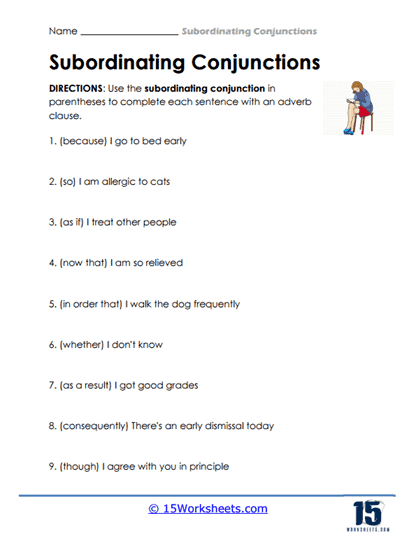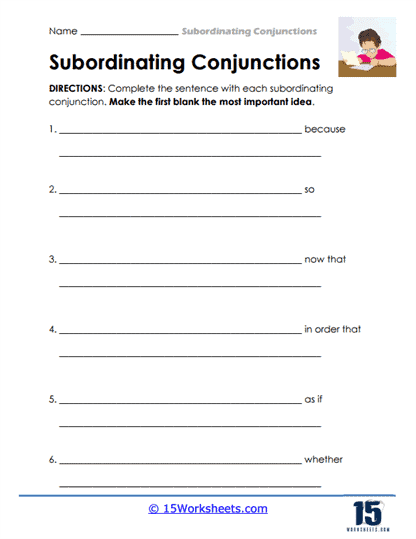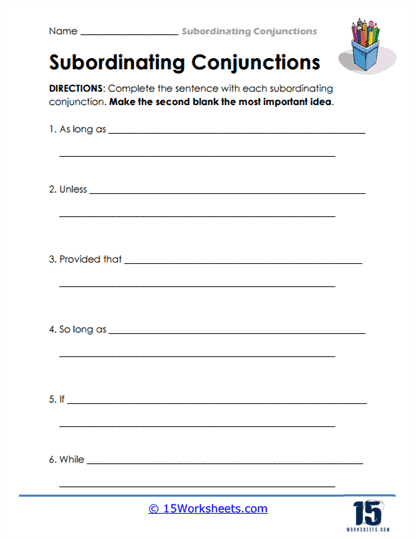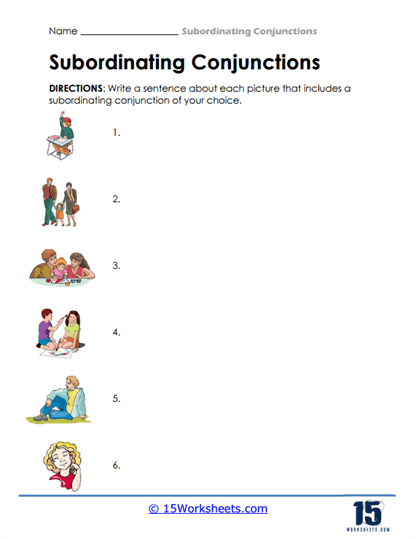Subordinating Conjunctions Worksheets
All About These 15 Worksheets
This series of worksheets will provide students with a deeper understanding of the role subordinating conjunctions play in English grammar, offering a structured yet dynamic way to grasp this essential concept. A subordinating conjunction is a crucial part of sentence structure, as it links a dependent clause to a main clause, creating complex sentences that convey more nuanced meaning. By mastering subordinating conjunctions, students can enhance both their writing and communication skills, learning how to craft sentences that flow naturally while expressing more sophisticated ideas. These worksheets offer a variety of interactive exercises and engaging activities that cater to different learning styles, making the learning process both enjoyable and effective.
The worksheets include a wide range of exercises, from fill-in-the-blank activities to sentence completion tasks, all of which are designed to reinforce the correct use of subordinating conjunctions. For instance, students are asked to identify subordinating conjunctions in pre-written sentences, allowing them to practice recognizing these key grammatical elements in context. By combining pairs of simple sentences using subordinating conjunctions, students also learn how to transform short, choppy sentences into smoother, more complex ones. This practice not only helps students understand sentence structure better but also shows them how to express more complex thoughts in a clear and coherent manner. The exercises gradually build in complexity, giving students the opportunity to apply their knowledge in a variety of contexts, from short writing prompts to more creative writing tasks. These varied formats ensure that students are actively engaged in the learning process, making it easier to retain information and apply it effectively in their own writing.
One of the standout features of these worksheets is the emphasis placed on helping students differentiate between subordinating conjunctions and coordinating conjunctions. While both types of conjunctions serve to connect clauses, their roles in a sentence are quite different. Subordinating conjunctions introduce dependent clauses, making the clause reliant on the main clause for its full meaning. On the other hand, coordinating conjunctions link independent clauses that can stand alone as complete thoughts. By learning to distinguish between these two types of conjunctions, students can better understand how to construct more varied and complex sentences. This distinction is critical for effective communication, as it helps students avoid run-on sentences and other common grammatical errors, allowing them to express themselves with greater clarity and precision.
The comprehensive approach of these worksheets ensures that students not only recognize and use subordinating conjunctions correctly but also understand their form and function within sentences. As students progress through the exercises, they gain a clearer understanding of how subordinating conjunctions help to show relationships between ideas, such as cause and effect, time, condition, and contrast. For example, conjunctions like “because,” “although,” and “since” help to explain why something happens or under what conditions. By practicing with these conjunctions, students learn how to add depth to their writing, moving beyond simple, straightforward statements to more complex and layered thoughts. This understanding is crucial for academic writing, storytelling, and even everyday communication, where the ability to convey nuanced ideas can make a significant difference.
These worksheets encourage students to apply what they’ve learned by creating their own sentences using subordinating conjunctions. This hands-on approach not only reinforces the material but also helps students gain confidence in their writing abilities. By creating their own examples, students see firsthand how subordinating conjunctions can be used to connect ideas, build arguments, and add complexity to their writing. This practical application is a key component of mastering grammar, as it moves students from passive learning to active engagement with the material. Additionally, the process of constructing sentences with subordinating conjunctions encourages critical thinking, as students must consider how different ideas relate to one another and how best to express those relationships in their writing.
What are Subordinating Conjunctions?
Subordinating conjunctions play a crucial role in sentence construction, allowing us to craft sentences that are not only more complex but also more nuanced in meaning. These small yet powerful words serve as the bridge between a dependent or subordinate clause and an independent clause, enhancing the depth and clarity of our communication. But what exactly does this mean, and how can mastering subordinating conjunctions elevate your writing? To understand their significance, let’s dive deeper into the mechanics of how these conjunctions function within sentences and why they are essential tools for effective communication.
At its core, a subordinating conjunction introduces a subordinate clause, which is a group of words that contains both a subject and a verb but lacks the capacity to stand alone as a complete sentence. This is where the magic of subordinating conjunctions comes in—they enable us to link this incomplete thought, or dependent clause, to an independent clause, which is a complete sentence in itself. By doing so, we can express more intricate relationships between ideas, such as cause and effect, time, contrast, or condition, that a simple sentence might overlook. For example, in the sentence “Although it was raining, we still went for a walk,” the word “although” signals a contrast between the two ideas, adding complexity and subtlety to the overall message. Without the subordinating conjunction, the sentence would lose much of its depth, becoming two separate and unrelated statements.
One of the most useful aspects of subordinating conjunctions is their ability to make sentences more flexible and fluid, allowing writers and speakers to express a wide range of meanings and relationships. Consider the sentence, “I stayed home because I was feeling sick.” Here, the subordinating conjunction “because” provides a clear cause-and-effect relationship, showing why the subject chose to stay home. By introducing the dependent clause in this way, the sentence gains clarity and purpose. Similarly, sentences like “If you study hard, you will pass the exam” or “Since it was his birthday, we decided to throw him a surprise party” use the subordinating conjunctions “if” and “since” to establish conditions and reasons for the actions described. This ability to clarify connections between ideas is what makes subordinating conjunctions invaluable for writers looking to communicate with precision and sophistication.
It’s also worth noting that the placement of the subordinate clause can vary within a sentence, offering even more flexibility in how information is presented. Typically, the subordinate clause comes after the independent clause, as in “I always drink coffee when I wake up in the morning.” In this sentence, “I always drink coffee” is the independent clause, and “when I wake up in the morning” is the subordinate clause, which provides a time frame for the action. However, in some cases, the subordinate clause can come first, as seen in the earlier example, “Although it was raining, we still went for a walk.” In this structure, the sentence opens with the subordinate clause, creating a sense of anticipation before the main action is revealed. This variation in structure not only keeps the writing dynamic but also allows the writer to emphasize different parts of the sentence, depending on which clause comes first.
Mastering subordinating conjunctions can significantly improve both your writing and speaking skills. By understanding how to connect dependent clauses with independent ones, you gain the ability to create sentences that are more than just basic statements. You can express complex thoughts, show relationships between ideas, and make your communication more engaging and thoughtful. For instance, instead of saying, “I missed the bus. I was late to work,” you could elevate the sentence by saying, “Because I missed the bus, I was late to work.” This revised sentence not only conveys the same information but does so with greater clarity and flow, showing the direct cause of the lateness.
Subordinating vs. Coordinating Conjunctions
Conjunctions are an essential part of any sentence structure, providing the linguistic glue that ties words, phrases, and clauses together. However, not all conjunctions function in the same way. Subordinating conjunctions and coordinating conjunctions, while both crucial for sentence construction, serve distinct purposes and follow different grammatical rules. Understanding these differences can dramatically improve your writing, allowing you to craft sentences that are not only grammatically correct but also varied and compelling.
Balancing the Equation
Coordinating conjunctions are used to connect two or more words, phrases, or clauses that hold equal grammatical weight within a sentence. Think of these as the balancing agents, ensuring that the parts of a sentence they connect are of similar importance. These coordinate elements can range from single words to entire clauses, and the relationship between them is one of equality. The most common coordinating conjunctions are simple, yet powerful: “and,” “or,” “but,” “nor,” “for,” “yet,” and “so.” Despite their brevity, these words play a crucial role in sentence structure, offering a way to combine ideas without subordinating one to the other.
For instance, in the sentence, “I want to go to the beach, but it’s raining,” the coordinating conjunction “but” connects two independent clauses that are equally important. Neither clause is dependent on the other; both could stand alone as separate sentences, yet the conjunction brings them together, highlighting the contrast between desire and reality. Similarly, in the example, “The book is long and difficult, but I’m enjoying it,” the conjunction “but” juxtaposes the challenging nature of the book with the speaker’s enjoyment, emphasizing a surprising contrast between difficulty and pleasure.
This equal footing that coordinating conjunctions provide allows for greater flexibility in writing. You can effortlessly connect ideas, build compound sentences, and ensure that your writing flows smoothly. The balance they create is particularly useful when expressing contrast, choice, or logical consequence, making coordinating conjunctions indispensable for constructing complex and nuanced thoughts.
Emphasizing Relationships
In contrast to coordinating conjunctions, subordinating conjunctions are used to link an independent clause to a dependent or subordinate clause. The key distinction here is that a subordinate clause, by itself, does not form a complete thought; it relies on the independent clause to provide meaning. Subordinating conjunctions thus introduce relationships of time, cause, condition, or contrast between two clauses, creating a hierarchy in which the dependent clause is less important than the independent one.
For example, in the sentence, “Because it was raining, I stayed inside,” the subordinating conjunction “because” establishes a cause-and-effect relationship between the two clauses. The dependent clause “because it was raining” cannot stand on its own as a sentence; it needs the independent clause “I stayed inside” to complete the thought. The subordinating conjunction here clearly defines the reason behind the action. Similarly, a sentence like “Although the book is long, I’m enjoying it” uses the subordinating conjunction “although” to introduce contrast, positioning the length of the book as a less significant factor in comparison to the enjoyment it provides.
Subordinating conjunctions, therefore, allow for more intricate sentence structures. By using them, you can create complex sentences that show how one idea relates to another, whether through cause, contrast, or condition. This adds depth to your writing, as it enables you to convey not just the information itself but the relationships between different pieces of information. These relationships can reflect time (“before,” “after”), reason (“because,” “since”), contrast (“although,” “though”), or condition (“if,” “unless”), among others. Mastering subordinating conjunctions is crucial for expressing more sophisticated and layered ideas.
The Importance of Knowing the Difference
Understanding the distinction between subordinating and coordinating conjunctions is vital for any writer seeking clarity and precision. While both types of conjunctions are used to connect ideas, they do so in fundamentally different ways. Coordinating conjunctions allow for the equal joining of ideas, letting each part stand with the same grammatical weight. On the other hand, subordinating conjunctions establish a clear relationship of dependence, highlighting how one idea supports, contrasts with, or is contingent upon another.
By knowing when to use each type of conjunction, you can enhance the flow of your writing and avoid common grammatical mistakes. Incorrectly using a subordinating conjunction in place of a coordinating one, or vice versa, can lead to unclear or fragmented sentences. For instance, writing “Although it’s raining, but I still want to go to the beach” misuses both types of conjunctions, leading to confusion. A clearer sentence would choose one approach: “Although it’s raining, I still want to go to the beach” or “It’s raining, but I still want to go to the beach.” The first uses a subordinating conjunction to express contrast through dependence, while the second uses a coordinating conjunction to balance two independent ideas.















